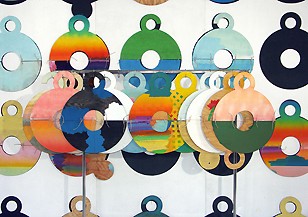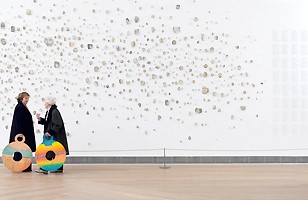
Enno Hallek, Portable Sunset, 2008 Photo: Peter Grimner/Moderna Museet
The 1st at Moderna: Enno Hallek
Portable Sunset
1.4 2008 – 18.5 2008
Stockholm
”The eternally temporary condition of painting is to change and redefine.”
Enno Hallek is a conceptual painter. At the heart of his work dwell the eternal painterly problems. How to arrange the surface? What choices to make and what alliances to enter into when painting a picture? What expressions to use and what manners to employ in applying the colour and in relating to reality? And who says that you have to paint on canvas, anyway? Ever since his student days at the art college, Enno Hallek has exploited every opportunity to vary his art and to break taboos. How come that the liberal arts are so unfree, seems to be a recurrent question. Why was it frowned upon to paint figuratively in the 1950s and early 1960s, and to devote oneself to colour and form in the early 1970s?
With defiant humour and poignant earnestness, Hallek has tested the boundaries. He has painted figuratively as well as abstractly and he has mixed the two, well, actually, he has tied them together quite literally, with one foot in Kandinsky’s chromatics, one in pop art, and so on. You could say that his work is an uninhibited survey of the history of art where nothing is orthodox and everything can collide, restricted only by the limitations of imagination.
Enno Hallek has never nourished the belief in all-encompassing images. Rather, his driving force has been, and continues to be, the multitude of perspectives. Such a generous strategy may alleviate the creative anguish over what to paint – as every image can be complemented by another image – but it entails other painterly problems. After a while, his store rooms became overcrowded by paintings to the extent that he felt compelled to do something in order to be able to continue working.
In 1990 he invented a system
From 1×1 metre plywood boards, he cuts out different shapes that he paints and joins with strings and wing nuts. His studio is now full of such pieces – modules that he uses like a palette of colours. He can turn, twist and replace pieces to generate new images. If he is not satisfied with the outcome, he can re-paint the pieces. It has turned into a kind of personal Lego that has consumed Hallek’s time and work for the last 18 years, like a creative addiction. His system contains everything that he will ever need: there are endless possibilities to create and modify without having to add further objects to the world.
Part of this project are the portable sunsets – a group of spherical paintings composed of two semicircular shapes, one of which is equipped with a handle. Joined by strings, the two semicircles meet to create a kind of horizon in which one can assume that a landscape meets the sky. Several of the paintings work in a sophisticated fashion with reflections between the two surfaces; others are purely excuses for painting. For the exhibition at Moderna Museet, we have assembled a large number of Hallek’s portable paintings. They are hung on nails on a large pattern of black silhouette images which mark the place where they belong, like tools in joiner’s workshop. However, they are only hanging there temporarily; their nature being portable – constantly changeable. And no matter how we arrange the paintings, we will never get rid of the black markers on the walls, which outnumber them. This is a futile struggle; there is always an empty surface to fill.
The exhibition series The 1st at Moderna has no dedicated space in which to display the works. Instead, we try to provide interesting contexts for the artists and unique conditions for the works. In the course of Enno Hallek’s exhibition, his portable paintings will have close encounters with the traditions and the history that he is so intimately connected to and so far removed from. The works will be set in motion through the art history by the museum’s own infrastructure or circulatory system – the visitors. On three Tuesdays we will place the paintings in the hands of you and your fellow visitors. The number of ensuing artistic encounters is only restricted by your curiosity and your movements through Moderna Museet’s collection. Perhaps these portable sunsets will meet Picasso, Malevich, Warhol, Stella, Richter and Mamma-Andersson – artists who have inspired Hallek as well as artists who have been educated by him at The Royal University College of Fine Arts here in Stockholm.
Curator: Fredrik Liew
Enno Hallek
Born in 1931 in Rohuküla, Estonia. Lives and works in Stockholm, Sweden.
Education
1953-1958 The Royal University College of Fine Arts, Stockholm, Sweden
Three solo exhibitions
2005 Konstakademien, Stockholm
1990 Art Museum of Estonia, Tallin
1968 Galerie Zunini, Paris, France
Three group exhibitions
2007 Culture Catapults, Haapsalu, Estonia
1994 Model 2000, Museu National de Belas Artes, Rio de Janeiro, Brasil
1982 Icebreakers. Contemporary Swedish Expressionists, The Clocktower, New York, USA

